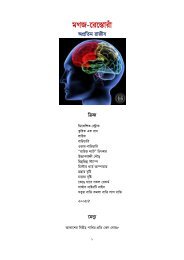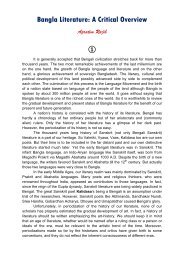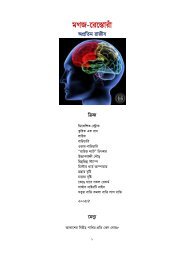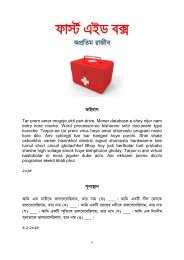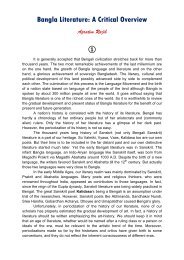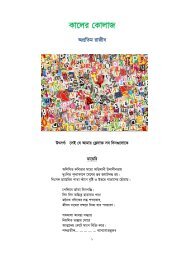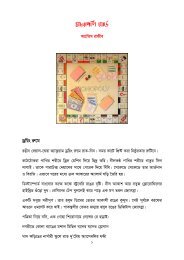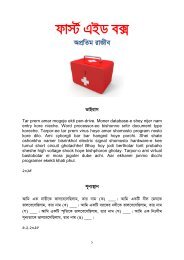Literature-Critique
You also want an ePaper? Increase the reach of your titles
YUMPU automatically turns print PDFs into web optimized ePapers that Google loves.
52<br />
Akhtaruzzaman Elias (1943-’97)<br />
Neither a huge number of works he has written, nor has he attempted. But his<br />
works have achieved a significant position in modern Bangla fiction. Elias’s fictions<br />
have equalized with the word ‘photorealism’. His each sentence is like the focus<br />
point of a camera. He mastered the narrative technique of fiction.<br />
His Chilekothar Sepai (The Soldier of an Attic) tells us of the mass revolution<br />
of 1969. Each word of the novel is like an inseparable brick of a grand palace. His<br />
depiction is vivid and heart-touching. He penetrates especially into the minds of the<br />
proletariat. Their lifestyle, behavior and talks (which may seem vulgar to any cultured<br />
mind) are drawn with brilliant skill. The historical revolution of a poor and exploited<br />
nation is depicted like cinematography. The picture of their poverty and deprivation<br />
too is realistic. The fact that the mass insurrection was carried on by the poorest and<br />
most exploited people, is mirrored here. The pictures of both village and city life are<br />
masterly drawn.<br />
The continuous exploitation and persecution of this impoverished nation by<br />
the foreign rulers made traumatic affect on the common people’s psyche. Thus<br />
alienation, a byproduct of the Pak-ruled tyrannical society, often made psychotic<br />
disorder. It is also evident that poetic expressions also sometimes appear in this<br />
work, though not as intensely as in Mahmudul Haq’s novels. An existential quest is<br />
also found in this master novel.<br />
His other novel – Khoabnama (The Tale of Dreams) is a masterpiece of Magic<br />
Realism. It tells us of heartbreak – both in personal and political life of the<br />
countrymen. Beginning in the British reign (during the Tebhaga movement), it is the<br />
story of a village, the folk of which is clad with superstitions and odd behaviors. An<br />
old man interprets people’s dreams with the use of a manuscript that previously<br />
belonged to his wife’s grandfather. However, dreams surround personal ambitions<br />
that differ from man to man. Some person’s aim is to get intimate to an imaginary<br />
power; some aspire for earthly fortune; a woman desires to have her favorite man;<br />
someone dreams of the return of a historically famous revolutionary.<br />
All dreams shatter after the partition of the country. The man searching for a<br />
supernatural idol drowns in the quicksand; the dreamer for a revolution is<br />
assassinated; communal riots occur and the country is flooded by the blood of<br />
innocent common people. The manuscript goes to a young woman’s hand who<br />
interprets people’s dreams in a new way. To her, dreams are no longer the most<br />
important matter; now more important is the men and women in the dreams. High<br />
ambitions are now constrained to some person’s own aspirations. Nights’ dreams<br />
are wrecked, but life goes on in its own way in quest of new dreams. Thus in this<br />
novel, the history of a political disaster is spoken in a symbolic way.<br />
His short stories focus on poverty-stricken proletariat people’s lives. Their<br />
shabby lifestyle, deprivation and vulgar practices are well-written in these stories. His<br />
short stories are collected in three anthologies titled Onyo Ghore Onyo Swor<br />
(Different Voices in Different Chambers), Dudhbhate Utpat (Disturbances in Eating<br />
Milk and Rice) and Dojokher Om (The Heat of Hell).




